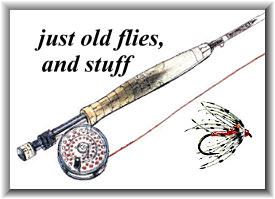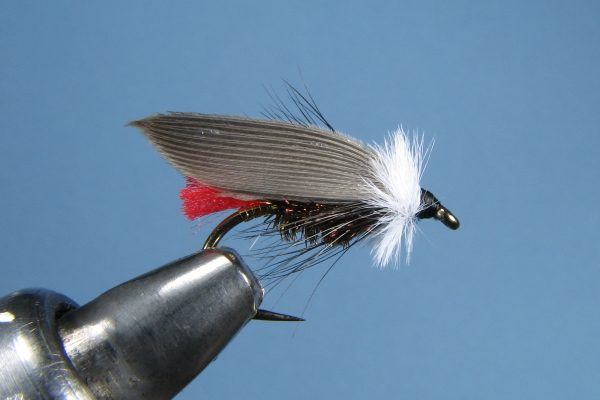
Welcome to 'just old flies,' a section of methods and flies that used-to-be. These flies were tied with the only materials available. Long before the advent of 'modern' tying materials, they were created and improved upon at a far slower pace than today's modern counterparts; limited by materials available and the tiers imagination.
Once long gone, there existed a 'fraternity' of anglers who felt an obligation to use only the 'standard' patterns of the day. We hope to bring a bit of nostalgia to these pages and to you. And sometimes what you find here will not always be about fishing. Perhaps you will enjoy them. Perhaps you will fish the flies. Perhaps?
WATERS

I thought I'd do something in a little different style this week. This Christmas I was given Helen Shaw's Flies for Fish and Fishermen, a book I've coveted for years. I knew of its existence, but even used, it was always quite pricey. My wife found one that appears to be new, somewhere on-line, and I've been studying away ever since.
In case you're not aware of Helen Shaw, I'll fill in a bit. She was from Wisconsin, and is widely regarded as one of the finest tiers and teachers of the 20th century. Her book Fly Tying: Materials, Tools and Techniques is a classic. She married the long-time Art Director of Field and Stream, Hermann Kessler, and they lived in upstate New York in her later years. She passed away in 2007.
Flies for Fish and Fisherman has a subtitle, "The Wet Flies", leading me to believe that there was to be at least one more book, perhaps "The Dry Flies", but alas, for reasons unknown, that wasn't to be. What I find most interesting about this book is the organization of the chapters. They are listed according to the seven body types of wet flies, herl, chenille, wool or yarn, dubbing, floss, quill, and tinsel. I took the "Waters" fly from the first chapter. Each chapter is subdivided into sections, starting with the simples flies, ones with only body and hackle, and working up to the most complicated, having body, wings, hackle, tag, tip, and tail. Recipes for flies that fill each bill of materials are listed in a chart, and most of the flies are shown at the beginning of the chapter on a full color plate. All the step by steps are in black and white, and the photography, done by her husband, is superb.
What I especially like about this book is that there are a number of flies presented with which I'm unfamiliar, Waters being one. There are also some flies skipped, most notably the Royal Coachman, Light Cahill, Hendrickson, Black Gnat, and Parmachene Belle, some of the most popular wet flies ever. Regardless, virtually every style and type of wet imaginable is covered, and many flies could sub for the ones skipped.
I found Helen Shaw's tying style most interesting. It really harkens back to an earlier time, before it was conventional for American tiers to pull the hackle down and out of the way. She sizes her hackle differently as well, taking it all the way to the bend of the hook rather than the barb as was customary with many tiers. One thing I learned right away from the book was how to deal with a bulky body. If you tie the wings on top of the hook, the body will tend to pop the wing up no matter what you do. Helen Shaw in that case starts by holding the far wing more on the side of the body, mating the near wing to it, and then tenting the wings over the body, almost like a caddis wing. This results in a much lower profile wing. I've tried to illustrate that with the fly above.
I haven't said much about the fly here, and that is simply because I don't know much about the fly. It's very much in the mold of the Leadwing Coachman, but the white ostrich herl head is unique to say the least. I can't find even a mention of the Waters anywhere else, and it may be a fly of Helen Shaw's own design.
While the wings of a majority of Helen Shaw's flies are set rather low, some aren't. Most are set with the tips together, with a very small number made with the tips apart. Always in evidence is her hackle style, which is a considerably "wilder" than was the norm for many of the wet flies I fished as a kid. I like this hackle style, and can only surmise that these would be great flies to fish. Here's the recipe for the Waters:
Waters
-
Tag: Gold tinsel
Tail: Red yarn or floss, trimmed short
Body: Peacock herl
Hackle: Black or dark grizzly
Wings: Slate goose or mallard
Head: White ostrich herl
Credits: Flies for Fish and Fishermen (The Wet Flies) by Helen Shaw ~ ELA
[ HOME ]
[ Search ] [ Contact FAOL ] [ Media Kit ]